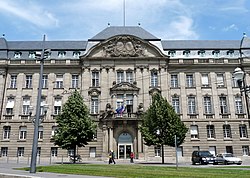Bas-Rhin (département)
| Bas-Rhin | |||
|---|---|---|---|
| Department | |||

Prefecture building of the Bas-Rhin department, in Strasbourg
|
|||
|
|||
 Location of Bas-Rhin in France |
|||
| Coordinates: 48°49′N 7°47′E / 48.817°N 7.783°ECoordinates: 48°49′N 7°47′E / 48.817°N 7.783°E | |||
| Country | France | ||
| Region | Grand Est | ||
| Prefecture | Strasbourg | ||
| Subprefectures |
Haguenau Molsheim Saverne Sélestat |
||
| Government | |||
| • President of the General Council | Guy-Dominique Kennel (UMP) | ||
| Area | |||
| • Total | 4,755 km2 (1,836 sq mi) | ||
| Population (2014) | |||
| • Total | 1,112,815 | ||
| • Rank | 18th | ||
| • Density | 234/km2 (610/sq mi) | ||
| Time zone | CET (UTC+1) | ||
| • Summer (DST) | CEST (UTC+2) | ||
| Department number | 67 | ||
| Arrondissements | 5 | ||
| Cantons | 23 | ||
| Communes | 517 | ||
| ^1 French Land Register data, which exclude estuaries, and lakes, ponds, and glaciers larger than 1 km2 | |||
Bas-Rhin (French pronunciation: [bɑ.ʁɛ̃]; Alsatian: Unterelsàss) is a department in the Grand Est region of France. The name means "Lower Rhine", however, geographically speaking it belongs to the Upper Rhine region. It is the more populous and densely populated of the two departments of the traditional Alsace region, with 1,112,815 inhabitants in 2014. The prefecture and the General Council are based in Strasbourg. The INSEE and Post Code is 67.
The inhabitants of the department are known as Bas-Rhinois or Bas-Rhinoises.
The Rhine has always been of great historical and economic importance to the area, and it forms the eastern border of Bas-Rhin. The area is also home to some of the foothills of the Vosges Mountains.
To the north of Bas-Rhin lies the Palatinate forest (Pfälzerwald) in the German State of Rhineland-Palatinate, and the German State of Baden-Württemberg lies to the east. To the south lies the department of Haut-Rhin, the town of Colmar and southern Alsace, and to the west the department of Moselle. On its southwestern corner, Bas-Rhin also joins the department of Vosges.
...
Wikipedia


